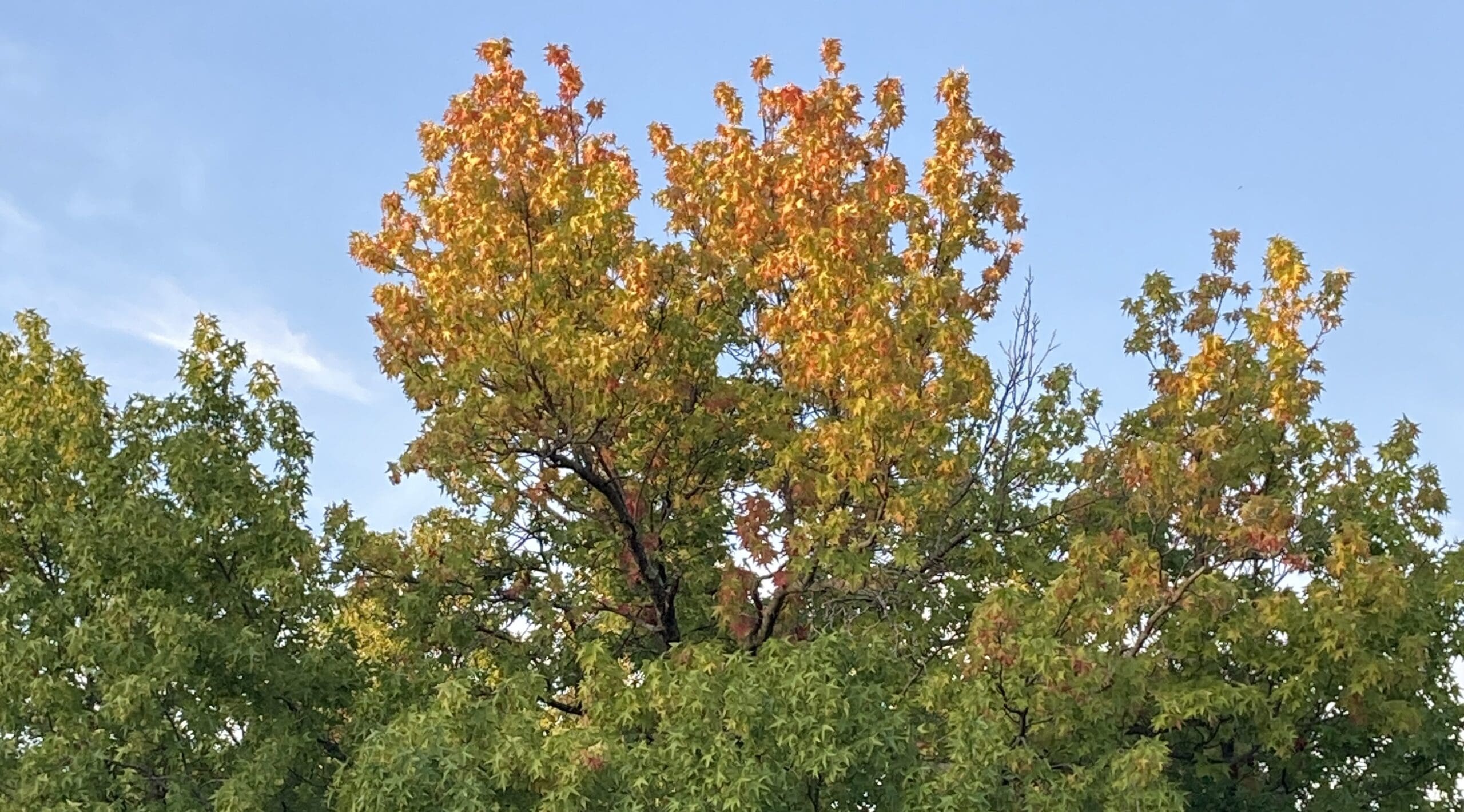As we transition from summer to autumn, I think about how slowly this process really happens, taking place not on or around a certain single day—that is, the first day of fall, the Equinox, this year Sept. 22—but instead, spanning several weeks.
I always delight in spotting the very first signs of these shifts all the way back at the end of July, in fact, in high summer, when autumn is still a distant thought away. The first leaf color-change I watch for is the one high up on the burning bushes which protect the side of our house from the traffic-y downtown street flanking our property. (“Bush” is a bit of a misnomer because these are very mature, and over 20 feet tall. I’ve also recently learned that burning bushes are non-native and in fact invasive, but they are so massive, rooted, old, and a beautiful crimson (in fall) that it seems somehow disrespectful to uproot and remove them.)
Next, usually just week or so later, I note a shift to orange at the very tops of the red maples situated in the office-building lot which I cross through daily on my walk, a couple of blocks from my house (pictured at the top of this post, taken on Aug. 8). In just a couple of weeks following this, they’ll shift to their trademark crimson.
So it begins in this way, every season’s change, as I chart nature’s shifts on certain key, natural “signposts” in my neighborhood. Noticing the progression of changes in each season keeps us grounded, something steady to count on as life throws us surprise after surprise, bringing shifts that are less predictable.
In accordance with the shifts to our physical environment, we begin to shift what we consume: seasonal fruits and vegetables (in autumn, apples and pears here and elsewhere; and soon, winter squashes), cozier spices like cinnamon, and slightly heavier foods as the weather slowly gets cooler. Coastal regions see changes to what is fresh for catching; for instance, France’s fabulous oyster season gets underway in October.
Summer-into-fall wine shifts
The same is true, of course, with wine! For white wines, as the air cools you could try shifting from a crisp and refreshing Pinot Grigio, perfect and uncomplicated for summer picnics and time outdoors in the heat, to a refreshing but slightly-fuller bodied Sauvignon Blanc: still lightweight enough to match the fading heat of day, but substantial enough to stand up to the cool evening air that comes as the sun fades.
A lesser-known white wine that I really recommend, however (especially if some of Sauvignon Blanc’s undertones are too “vegetal” for you—not not an issue for me, who loves these flavors, but understands that for some people, it’s not suited to their taste) is Pinot Gris (“gree”).
Summer-into-fall wine feature: Pinot Gris
Pinot Gris is the exact same varietal (“grape type”) as Pinot Grigio, which is its Italian name and version.
However, the use of the French name, Pinot Gris, usually indicates a difference in style: that is, differences in 1) viticulture/growing practices, for example letting the grapes ripen longer on the vine to increase sugar content and decrease acidity, plus 2) the art of how a grape varietal is then “crafted” by the winemaker during the winemaking process. Thus even if a wine is produced outside of France but is labelled “Pinot Gris,” you’ll know that it is more in line with the French style (usually hailing from the region of Alsace) of this wine. If it is produced outside of Italy but labelled with its Italian moniker, “Pinot Grigio,” you’ll know it’s more aligned with its Italian counterpart, as far as style.
Moving from Pinot Grigio to a Pinot Gris, you’ll notice a style shift from light- to more medium-bodied, a slight drop in the high acidity characteristic of Pinot Grigio, and the fruit flavors moving from fresh green apple and lemon into more of the riper green-apple and lemon realm, plus the addition of flavors and aromas of stone fruit (peach, apricot), sometimes tropical fruits like mango, and occasionally the presence of white flowers.
In addition, some Pinot Gris, especially ones actually made in France where it gets its name, can even have a hint of residual sweetness, and be medium to full-bodied with hits of ginger or honey. (That sounds inviting for autumn!)
Pinot Gris often goes unnoticed, with many people who are looking for a more substantial white wine reaching instead for a (better-known, at least in this country), Sauvignon Blanc, Riesling, or medium to full-bodied Chardonnay. Therefore, Pinot Gris is often somewhat of a hidden gem, and something different to try at your next visit to the wine shop or next peruse of a restaurant’s wine list.
Pinot Gris food pairings:
When I worked as a viticulture intern at Etude winery in Napa Valley, Jon Priest, outstanding head winemaker, remarked that the Etude Pinot Gris was actually one of his favorites of all of the wine he creates. When I had my first taste, I could see why: it had the characteristic Pinot Gris flavors of green apple, peach (here, white peach), slight undertones of white flowers, and a hint of marzipan. It was incredibly smooth and well-balanced, marks of a stellar wine.
In addition to being an answer for a lovely “transition wine” into Fall, Pinot Gris is, generally, also a terrific and versatile food wine. While its Italian counterpart, Pinot Grigio, pairs well with lighter fish and seafood, salads, and other summer fare, Pinot Gris, typically more medium-bodied and fuller-flavored (almost all wine styles have variation within their category!) can stand up to “heavier” seafood like shrimp and scallops and more substantial fish like snapper and bass, or to most varieties of fried fish. It is even a good match for roasted or grilled poultry, veal, and pork. A mushroom risotto will also usually be a lovely pairing.
These are general guidelines; just like with all wines, each specific Pinot Gris varies based on the growing and winemaking practices used, all of which impact the final product in the bottle.
A note about white wines: some people tend to skip white wine entirely, thinking that red wine is always better for food. Not at all the case! Something that a lot of wine consumers, who are still developing their palate, haven’t yet realized is that a medium to fuller-bodied white wine is generally more versatile with much if not most food, as compared to the majority of red wines (excepting lighter red wines like Pinot Noir). Red wine typically has a more complex flavor profile, and its flavors can therefore compete with a lot of foods in a non-harmonious way, so food pairings often require a bit more nuance and care.
Consistently-great regions for Pinot Gris:
Some of the best regions to look for on the label (again, we can only speak generally!) are:
Alsace, France
Oregon, USA
and California regions with moderate/cooler climates, such as:
Sonoma County
The Carneros AVA region of Napa Valley (the rest of Napa Valley is generally too hot for this varietal)
Anderson Valley AVA (in Mendocino County)
Again, this list is not exhaustive, and not totally fail-safe, but is a good general guide for you to start to explore this delicious wine style.
If you’d like to learn more about how the same grape types (here, Pinot Grigio / Pinot Gris) can end up very different in the bottle, more about food pairings or wines in general, and more about which regions are outstanding for which types of grapes, join Tango Wine Club! Through education-focused wine workshops, you’ll learn fascinating and practical tips to help you be a better wine consumer and will also come to understand which varietals and wine styles best suit your own tastes.


